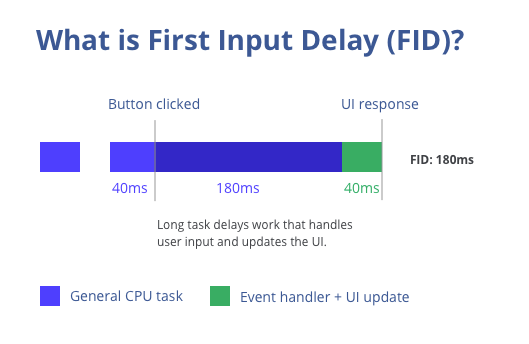What Is First Input Delay and How To Improve It — Top-4 Tips
Site Audit Issues
The first input delay (FID) calculates the amount of time from when you interact with a page for the first time (e.g., tap on a button) to the time when the browser can start processing event handlers in order to respond to that interaction. In other words, this metric measures your users' first impression of how responsive and interactive your website is, and sometimes, it may need improvement.
This post will cover what can delay your website's responsiveness and share some handy tips on solving this.
What’s a Good FID Score?
If you want to provide an excellent user experience, the first input delay of your website should have a value of 100ms or less. Anything between 100 and 300 has room for improvement, while a score of 300 and higher is considered poor.
You should keep in mind that the browser also needs to run the task associated with the user input, and that's something the FID doesn’t measure. That means that in some cases, your FID score might be 100ms or less, but the page may still seem somewhat unresponsive.
How Do You Measure a Website's FID Score?

There are several ways you can calculate the FID page speed:
For a single URL

The easiest way to calculate an FID score for a web page is to run it through Google PageSpeed Insights. However, keep in mind the first input delay score is based on field data, so it won't always be available. If that's a new web page that has yet to have enough visitors, you might not be able to calculate the score.
You can find the insights in the publicly available Chrome User Experience Report. It contains information about the types of devices and the connection speed of the user base. Another option to get FID-related insights is the Core Web Vitals report generated by Google Search Console.
For multiple URLs or an entire website
Another way of analyzing the input delay score is to install the web-vitals JavaScript library on the web server with a custom on-page embedded code. This library features a simple call that can automatically calculate the FID score for a target web page and add it to the analytics console. The recorded values are recorded from different users and devices.
What Triggers the Delay?
The first input delay usually happens due to the browser's main thread running other processes, making it respond to the user later. For instance, the browser might be parsing and executing a JavaScript file loaded by an application. It can't run any event listeners simultaneously because the JavaScript it's currently loading commands it to complete another task.
How To Improve Your Website's FID Score
Now that you know what FID pagespeed is and what can cause it to deteriorate, let's look at the possible ways to improve it.
Reduce the amount of JavaScript
Reducing the amount of JavaScript running on a web page will decrease the time for the browser to execute the JavaScript. Hence, the browser will be ready to handle user interactions and respond to them sooner. Some of the easiest ways to reduce JavaScript execution time is to eliminate unused JavaScript or remove unused polyfills, if there are any.
Load JavaScript later if you can
If you have any JavaScript that's not urgent, load it later. The two main ways to do so include using the defer and async attributes you can add to your script tags.
Usually, a script blocks the parser while downloading and executing. The async attribute will let the parsing and downloading start simultaneously; however, they will still block the parsing during script execution. Defer will not block the parsing as it downloads and will only begin executing after the HTML has finished parsing.
Break up long JavaScript tasks
Long JavaScript tasks running on the main thread can make your page less responsive to user interactions. Breaking the long-running tasks into smaller ones would be a perfect solution.
To determine if a task is long-running, look at the JavaScript task in the main thread. If it occupies the thread for more than 50ms, this is a long task. Break it into smaller, asynchronous ones to ensure they don’t run simultaneously.
Use the web workers
Another way of improving the FID page speed is to move some of the JavaScript to a web worker who can help you out, but you have to make sure it's a highly skilled developer to avoid potential errors or failed deadlines.
Use prerendering or server-side rendering (SSR)
Server-side rendering can help your website load faster and facilitate the indexing process for search engines. Since FID is one of Google’s Core Web Vitals, SSR generally provides an advantage in optimizing the data extracted from them.
If you’re on a JavaScript framework, there will be a lot of JavaScript required for a page to load. That JavaScript can process in the browser for quite a while, thus causing delays. By using prerendering or SSR, you transmit this load from a browser to the server.
How To Check Your FID Score with Netpeak Spider?
Running regular website audits is another vital way of maintaining the proper FID pagespeed score, and Netpeak Spider will help you with that. This multifunctional web crawler detects over 100 on-page- and other SEO-related issues.
Thanks to the app, you can track your website's metrics in real time, download research results in a convenient PDF format for further SEO needs, and integrate data from other services for in-depth data gathering.
Moreover, Netpeak Spider is extremely easy to work with. All you have to do to receive the information you need is follow these quick steps:
- Prepare the list of URLs you need to check or paste it from a clipboard into the search bar at the top panel
- On the right sidebar, select all the metrics you need to check
- Click "Start" to launch the crawling process
Here's more of what you can do with this handy, powerful tool:
Data filters and segmentation
Our tool breaks down research insights into segments and lets you track only the needed parameters. Use an interactive dashboard, set custom filters, or even change the data overview for more convenient data gathering.
Internal PageRank calculator
The internal PageRank calculator keeps track of pages' internal linking. You'll be able to check the link weight distribution on any target page and see which one burns incoming link equity or doesn't get any of it at all.
Integrations with Google Analytics and Search Console
Netpeak Spider allows you to retrieve the data from Google Analytics and Search Console to enrich the research data. This way, you access essential insights on traffic, your pages' goals, conversion rates, and other significant eCommerce parameters.
Bottom line
The first input delay shows how responsive and interactive your website is — it's crucial in creating an excellent UX and delivering the requested information faster to users.
To make sure your pages load quickly and users don't experience any delays, you should regularly check them using dedicated SEO tools like Netpeak Spider. Try it today and improve your website's responsiveness right away!


.png)
